Food Service Management Report: Wagamama Restaurant Analysis
VerifiedAdded on 2023/01/18
|14
|4742
|32
Report
AI Summary
This report provides a comprehensive analysis of food service management, using Wagamama restaurant as a case study. It explores various aspects, including different food supply chain approaches, such as proximate short food supply chains and fine dining services, and discusses the principles of effective procurement and sourcing processes. The report examines the application of analytical tools, like SWOT analysis, to assess Wagamama's strengths, weaknesses, opportunities, and threats. It also investigates the impact of ethical practices within the restaurant and evaluates current management practices, offering recommendations for improvement and outlining an implementation plan. The analysis covers organizational effectiveness, management strategies, and the importance of supply chain approaches in enhancing business operations, ultimately aiming to provide insights into optimizing food service management within the hospitality industry.
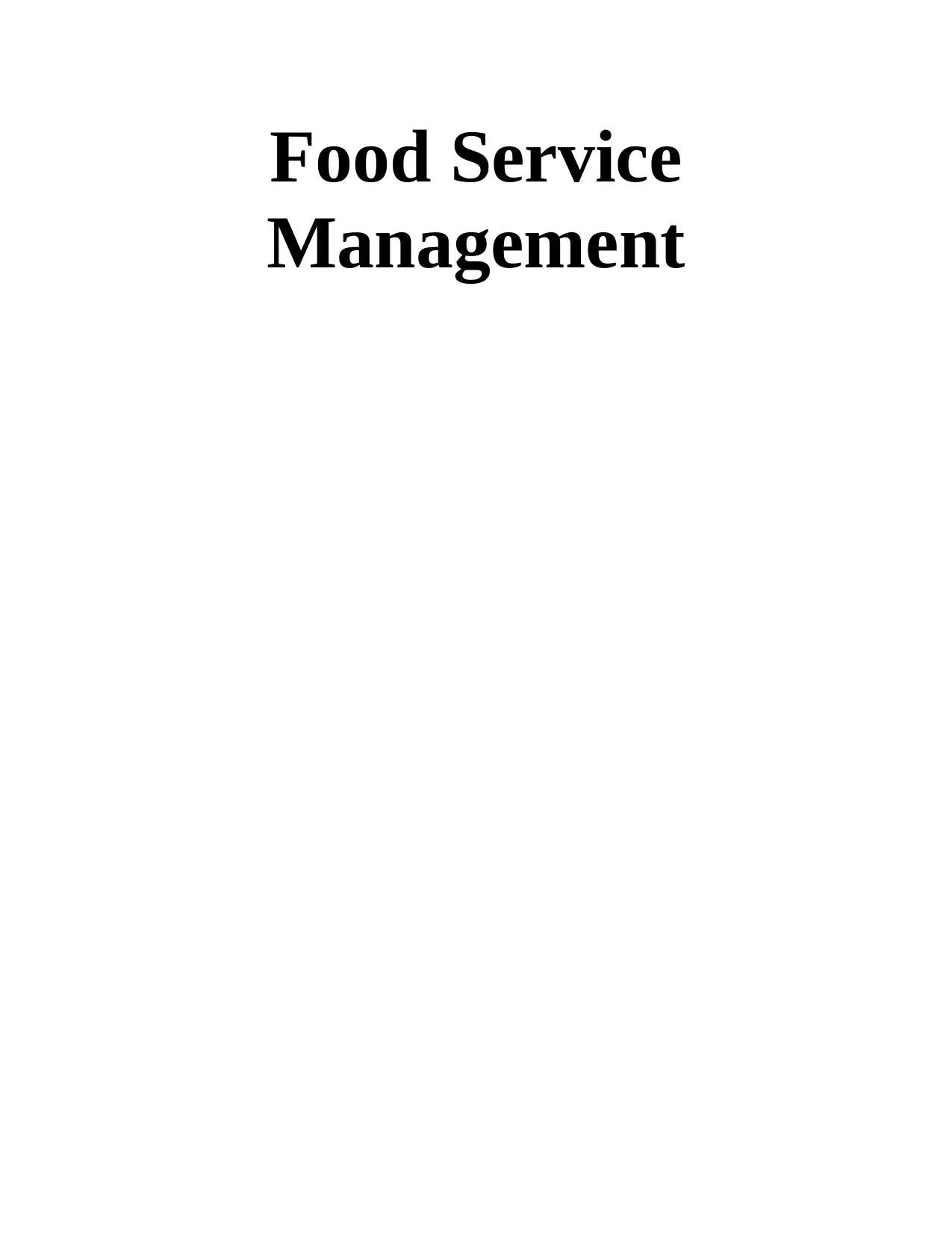
Food Service
Management
Management
Paraphrase This Document
Need a fresh take? Get an instant paraphrase of this document with our AI Paraphraser
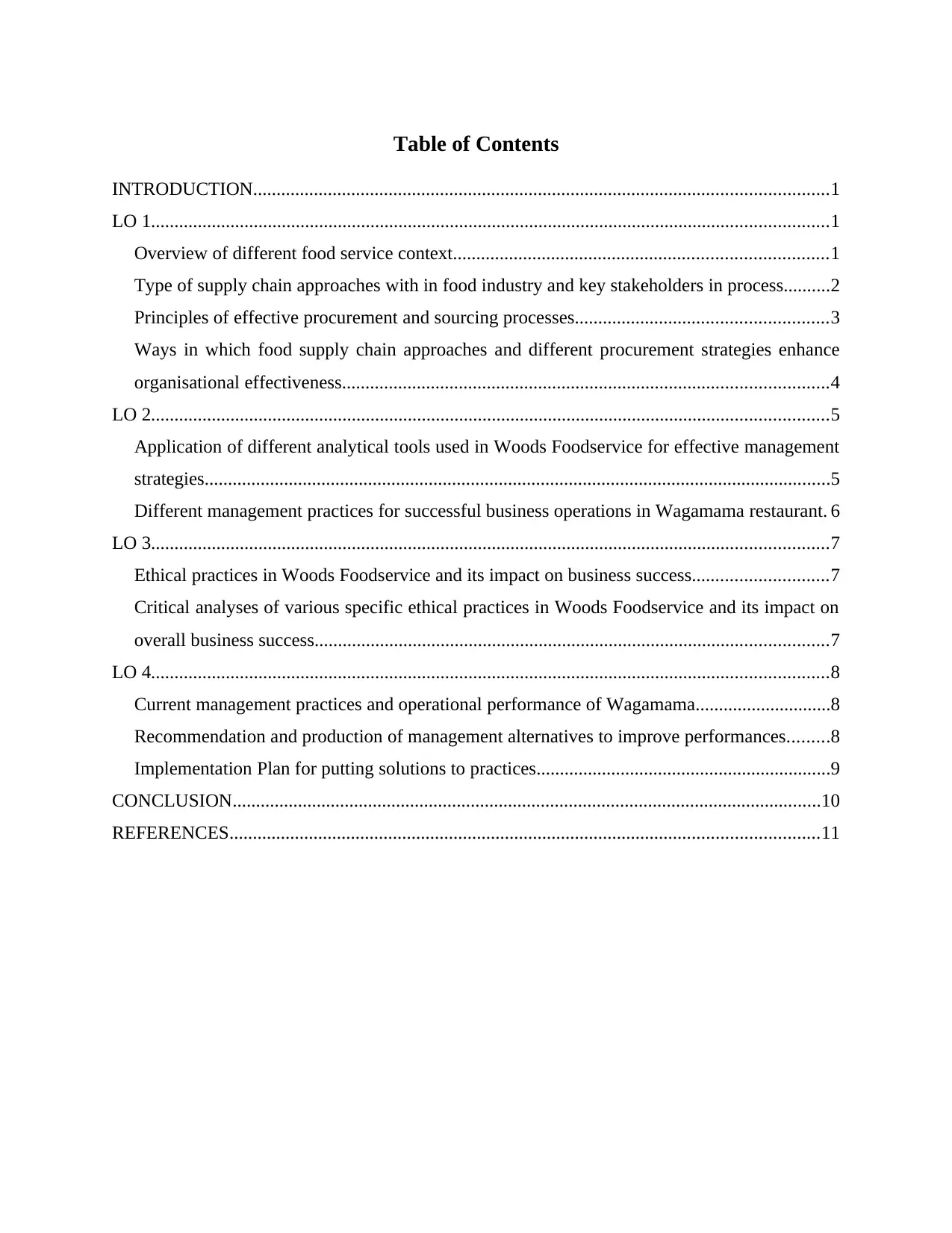
Table of Contents
INTRODUCTION...........................................................................................................................1
LO 1.................................................................................................................................................1
Overview of different food service context................................................................................1
Type of supply chain approaches with in food industry and key stakeholders in process..........2
Principles of effective procurement and sourcing processes......................................................3
Ways in which food supply chain approaches and different procurement strategies enhance
organisational effectiveness........................................................................................................4
LO 2.................................................................................................................................................5
Application of different analytical tools used in Woods Foodservice for effective management
strategies......................................................................................................................................5
Different management practices for successful business operations in Wagamama restaurant. 6
LO 3.................................................................................................................................................7
Ethical practices in Woods Foodservice and its impact on business success.............................7
Critical analyses of various specific ethical practices in Woods Foodservice and its impact on
overall business success..............................................................................................................7
LO 4.................................................................................................................................................8
Current management practices and operational performance of Wagamama.............................8
Recommendation and production of management alternatives to improve performances.........8
Implementation Plan for putting solutions to practices...............................................................9
CONCLUSION..............................................................................................................................10
REFERENCES..............................................................................................................................11
INTRODUCTION...........................................................................................................................1
LO 1.................................................................................................................................................1
Overview of different food service context................................................................................1
Type of supply chain approaches with in food industry and key stakeholders in process..........2
Principles of effective procurement and sourcing processes......................................................3
Ways in which food supply chain approaches and different procurement strategies enhance
organisational effectiveness........................................................................................................4
LO 2.................................................................................................................................................5
Application of different analytical tools used in Woods Foodservice for effective management
strategies......................................................................................................................................5
Different management practices for successful business operations in Wagamama restaurant. 6
LO 3.................................................................................................................................................7
Ethical practices in Woods Foodservice and its impact on business success.............................7
Critical analyses of various specific ethical practices in Woods Foodservice and its impact on
overall business success..............................................................................................................7
LO 4.................................................................................................................................................8
Current management practices and operational performance of Wagamama.............................8
Recommendation and production of management alternatives to improve performances.........8
Implementation Plan for putting solutions to practices...............................................................9
CONCLUSION..............................................................................................................................10
REFERENCES..............................................................................................................................11

⊘ This is a preview!⊘
Do you want full access?
Subscribe today to unlock all pages.

Trusted by 1+ million students worldwide
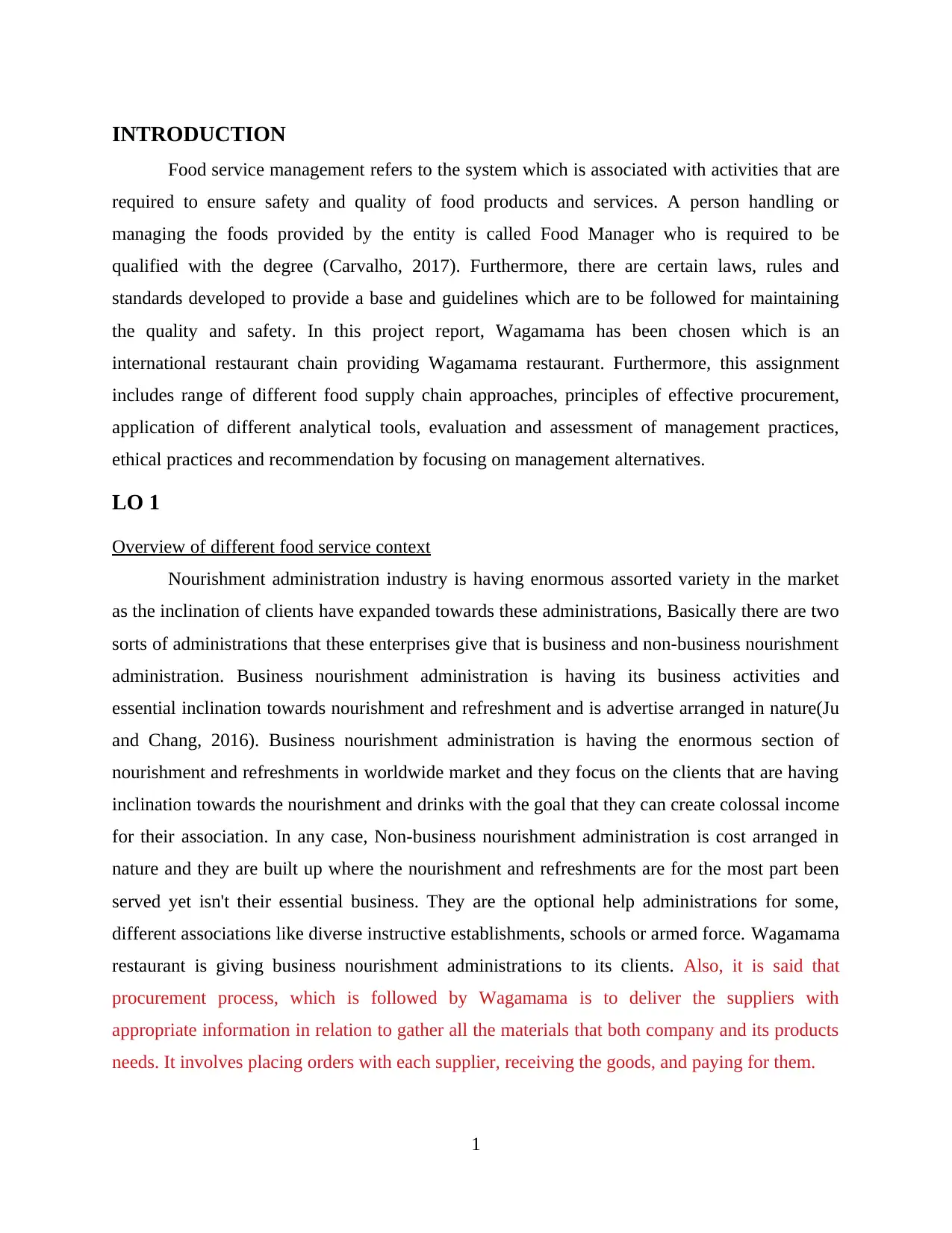
INTRODUCTION
Food service management refers to the system which is associated with activities that are
required to ensure safety and quality of food products and services. A person handling or
managing the foods provided by the entity is called Food Manager who is required to be
qualified with the degree (Carvalho, 2017). Furthermore, there are certain laws, rules and
standards developed to provide a base and guidelines which are to be followed for maintaining
the quality and safety. In this project report, Wagamama has been chosen which is an
international restaurant chain providing Wagamama restaurant. Furthermore, this assignment
includes range of different food supply chain approaches, principles of effective procurement,
application of different analytical tools, evaluation and assessment of management practices,
ethical practices and recommendation by focusing on management alternatives.
LO 1
Overview of different food service context
Nourishment administration industry is having enormous assorted variety in the market
as the inclination of clients have expanded towards these administrations, Basically there are two
sorts of administrations that these enterprises give that is business and non-business nourishment
administration. Business nourishment administration is having its business activities and
essential inclination towards nourishment and refreshment and is advertise arranged in nature(Ju
and Chang, 2016). Business nourishment administration is having the enormous section of
nourishment and refreshments in worldwide market and they focus on the clients that are having
inclination towards the nourishment and drinks with the goal that they can create colossal income
for their association. In any case, Non-business nourishment administration is cost arranged in
nature and they are built up where the nourishment and refreshments are for the most part been
served yet isn't their essential business. They are the optional help administrations for some,
different associations like diverse instructive establishments, schools or armed force. Wagamama
restaurant is giving business nourishment administrations to its clients. Also, it is said that
procurement process, which is followed by Wagamama is to deliver the suppliers with
appropriate information in relation to gather all the materials that both company and its products
needs. It involves placing orders with each supplier, receiving the goods, and paying for them.
1
Food service management refers to the system which is associated with activities that are
required to ensure safety and quality of food products and services. A person handling or
managing the foods provided by the entity is called Food Manager who is required to be
qualified with the degree (Carvalho, 2017). Furthermore, there are certain laws, rules and
standards developed to provide a base and guidelines which are to be followed for maintaining
the quality and safety. In this project report, Wagamama has been chosen which is an
international restaurant chain providing Wagamama restaurant. Furthermore, this assignment
includes range of different food supply chain approaches, principles of effective procurement,
application of different analytical tools, evaluation and assessment of management practices,
ethical practices and recommendation by focusing on management alternatives.
LO 1
Overview of different food service context
Nourishment administration industry is having enormous assorted variety in the market
as the inclination of clients have expanded towards these administrations, Basically there are two
sorts of administrations that these enterprises give that is business and non-business nourishment
administration. Business nourishment administration is having its business activities and
essential inclination towards nourishment and refreshment and is advertise arranged in nature(Ju
and Chang, 2016). Business nourishment administration is having the enormous section of
nourishment and refreshments in worldwide market and they focus on the clients that are having
inclination towards the nourishment and drinks with the goal that they can create colossal income
for their association. In any case, Non-business nourishment administration is cost arranged in
nature and they are built up where the nourishment and refreshments are for the most part been
served yet isn't their essential business. They are the optional help administrations for some,
different associations like diverse instructive establishments, schools or armed force. Wagamama
restaurant is giving business nourishment administrations to its clients. Also, it is said that
procurement process, which is followed by Wagamama is to deliver the suppliers with
appropriate information in relation to gather all the materials that both company and its products
needs. It involves placing orders with each supplier, receiving the goods, and paying for them.
1
Paraphrase This Document
Need a fresh take? Get an instant paraphrase of this document with our AI Paraphraser
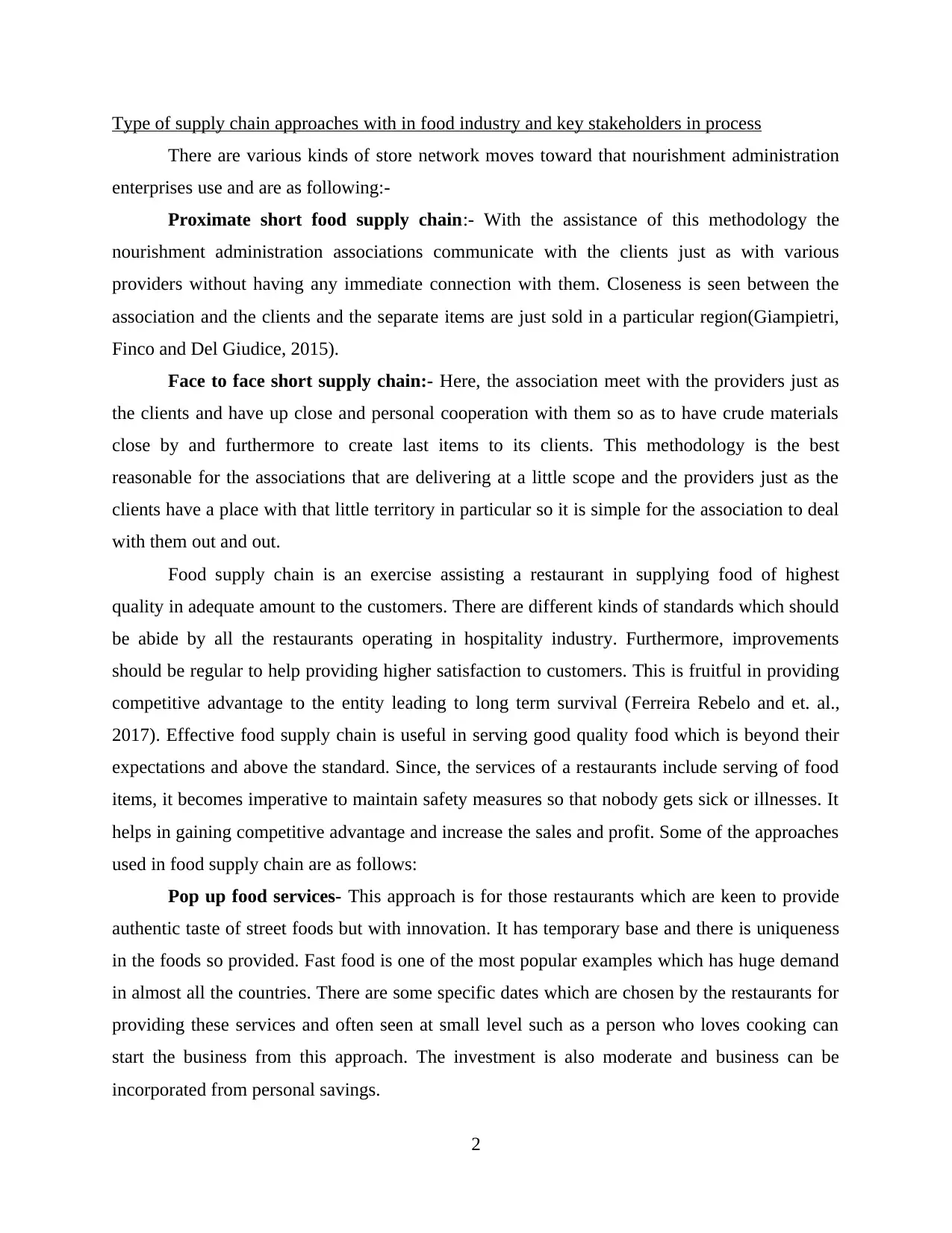
Type of supply chain approaches with in food industry and key stakeholders in process
There are various kinds of store network moves toward that nourishment administration
enterprises use and are as following:-
Proximate short food supply chain:- With the assistance of this methodology the
nourishment administration associations communicate with the clients just as with various
providers without having any immediate connection with them. Closeness is seen between the
association and the clients and the separate items are just sold in a particular region(Giampietri,
Finco and Del Giudice, 2015).
Face to face short supply chain:- Here, the association meet with the providers just as
the clients and have up close and personal cooperation with them so as to have crude materials
close by and furthermore to create last items to its clients. This methodology is the best
reasonable for the associations that are delivering at a little scope and the providers just as the
clients have a place with that little territory in particular so it is simple for the association to deal
with them out and out.
Food supply chain is an exercise assisting a restaurant in supplying food of highest
quality in adequate amount to the customers. There are different kinds of standards which should
be abide by all the restaurants operating in hospitality industry. Furthermore, improvements
should be regular to help providing higher satisfaction to customers. This is fruitful in providing
competitive advantage to the entity leading to long term survival (Ferreira Rebelo and et. al.,
2017). Effective food supply chain is useful in serving good quality food which is beyond their
expectations and above the standard. Since, the services of a restaurants include serving of food
items, it becomes imperative to maintain safety measures so that nobody gets sick or illnesses. It
helps in gaining competitive advantage and increase the sales and profit. Some of the approaches
used in food supply chain are as follows:
Pop up food services- This approach is for those restaurants which are keen to provide
authentic taste of street foods but with innovation. It has temporary base and there is uniqueness
in the foods so provided. Fast food is one of the most popular examples which has huge demand
in almost all the countries. There are some specific dates which are chosen by the restaurants for
providing these services and often seen at small level such as a person who loves cooking can
start the business from this approach. The investment is also moderate and business can be
incorporated from personal savings.
2
There are various kinds of store network moves toward that nourishment administration
enterprises use and are as following:-
Proximate short food supply chain:- With the assistance of this methodology the
nourishment administration associations communicate with the clients just as with various
providers without having any immediate connection with them. Closeness is seen between the
association and the clients and the separate items are just sold in a particular region(Giampietri,
Finco and Del Giudice, 2015).
Face to face short supply chain:- Here, the association meet with the providers just as
the clients and have up close and personal cooperation with them so as to have crude materials
close by and furthermore to create last items to its clients. This methodology is the best
reasonable for the associations that are delivering at a little scope and the providers just as the
clients have a place with that little territory in particular so it is simple for the association to deal
with them out and out.
Food supply chain is an exercise assisting a restaurant in supplying food of highest
quality in adequate amount to the customers. There are different kinds of standards which should
be abide by all the restaurants operating in hospitality industry. Furthermore, improvements
should be regular to help providing higher satisfaction to customers. This is fruitful in providing
competitive advantage to the entity leading to long term survival (Ferreira Rebelo and et. al.,
2017). Effective food supply chain is useful in serving good quality food which is beyond their
expectations and above the standard. Since, the services of a restaurants include serving of food
items, it becomes imperative to maintain safety measures so that nobody gets sick or illnesses. It
helps in gaining competitive advantage and increase the sales and profit. Some of the approaches
used in food supply chain are as follows:
Pop up food services- This approach is for those restaurants which are keen to provide
authentic taste of street foods but with innovation. It has temporary base and there is uniqueness
in the foods so provided. Fast food is one of the most popular examples which has huge demand
in almost all the countries. There are some specific dates which are chosen by the restaurants for
providing these services and often seen at small level such as a person who loves cooking can
start the business from this approach. The investment is also moderate and business can be
incorporated from personal savings.
2
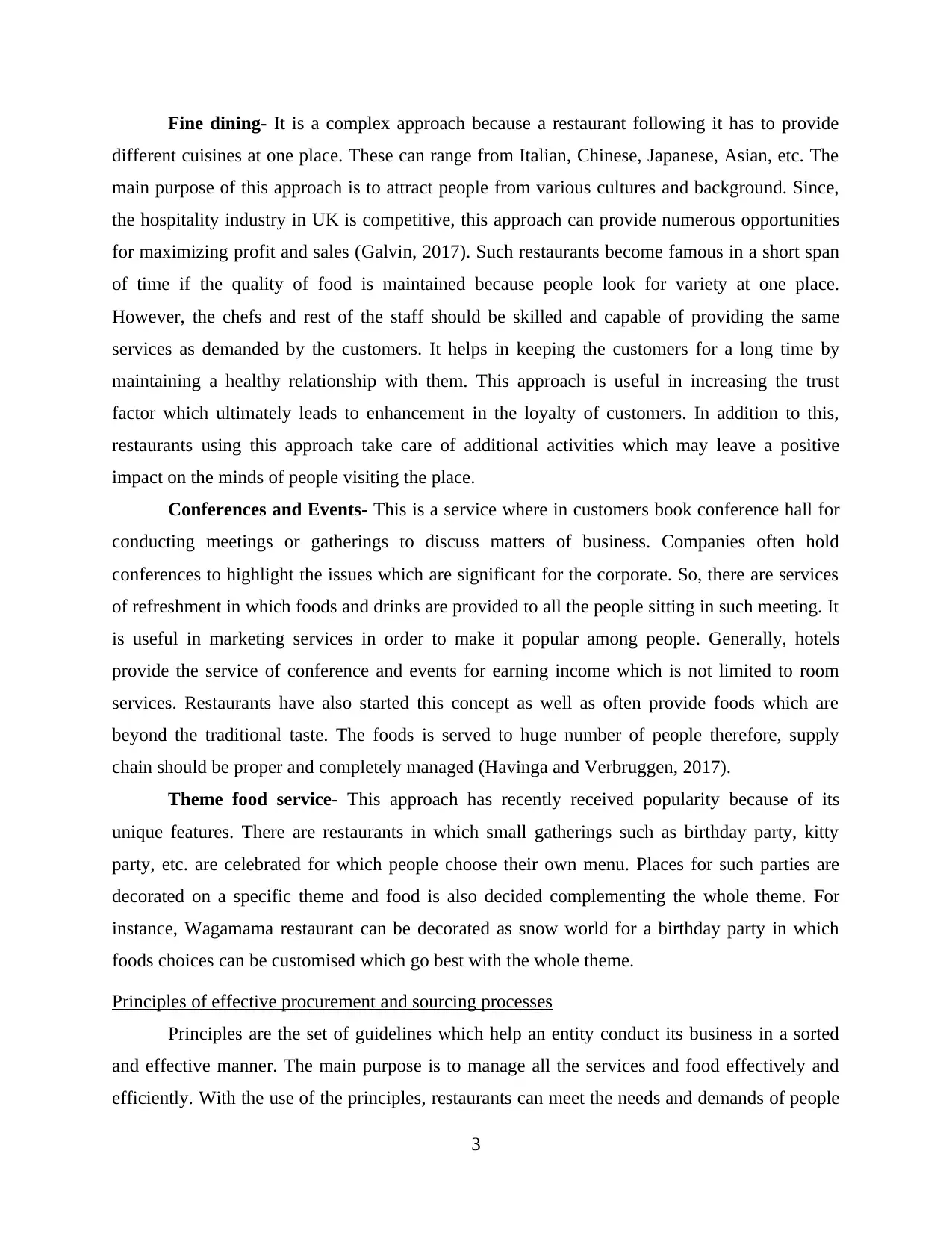
Fine dining- It is a complex approach because a restaurant following it has to provide
different cuisines at one place. These can range from Italian, Chinese, Japanese, Asian, etc. The
main purpose of this approach is to attract people from various cultures and background. Since,
the hospitality industry in UK is competitive, this approach can provide numerous opportunities
for maximizing profit and sales (Galvin, 2017). Such restaurants become famous in a short span
of time if the quality of food is maintained because people look for variety at one place.
However, the chefs and rest of the staff should be skilled and capable of providing the same
services as demanded by the customers. It helps in keeping the customers for a long time by
maintaining a healthy relationship with them. This approach is useful in increasing the trust
factor which ultimately leads to enhancement in the loyalty of customers. In addition to this,
restaurants using this approach take care of additional activities which may leave a positive
impact on the minds of people visiting the place.
Conferences and Events- This is a service where in customers book conference hall for
conducting meetings or gatherings to discuss matters of business. Companies often hold
conferences to highlight the issues which are significant for the corporate. So, there are services
of refreshment in which foods and drinks are provided to all the people sitting in such meeting. It
is useful in marketing services in order to make it popular among people. Generally, hotels
provide the service of conference and events for earning income which is not limited to room
services. Restaurants have also started this concept as well as often provide foods which are
beyond the traditional taste. The foods is served to huge number of people therefore, supply
chain should be proper and completely managed (Havinga and Verbruggen, 2017).
Theme food service- This approach has recently received popularity because of its
unique features. There are restaurants in which small gatherings such as birthday party, kitty
party, etc. are celebrated for which people choose their own menu. Places for such parties are
decorated on a specific theme and food is also decided complementing the whole theme. For
instance, Wagamama restaurant can be decorated as snow world for a birthday party in which
foods choices can be customised which go best with the whole theme.
Principles of effective procurement and sourcing processes
Principles are the set of guidelines which help an entity conduct its business in a sorted
and effective manner. The main purpose is to manage all the services and food effectively and
efficiently. With the use of the principles, restaurants can meet the needs and demands of people
3
different cuisines at one place. These can range from Italian, Chinese, Japanese, Asian, etc. The
main purpose of this approach is to attract people from various cultures and background. Since,
the hospitality industry in UK is competitive, this approach can provide numerous opportunities
for maximizing profit and sales (Galvin, 2017). Such restaurants become famous in a short span
of time if the quality of food is maintained because people look for variety at one place.
However, the chefs and rest of the staff should be skilled and capable of providing the same
services as demanded by the customers. It helps in keeping the customers for a long time by
maintaining a healthy relationship with them. This approach is useful in increasing the trust
factor which ultimately leads to enhancement in the loyalty of customers. In addition to this,
restaurants using this approach take care of additional activities which may leave a positive
impact on the minds of people visiting the place.
Conferences and Events- This is a service where in customers book conference hall for
conducting meetings or gatherings to discuss matters of business. Companies often hold
conferences to highlight the issues which are significant for the corporate. So, there are services
of refreshment in which foods and drinks are provided to all the people sitting in such meeting. It
is useful in marketing services in order to make it popular among people. Generally, hotels
provide the service of conference and events for earning income which is not limited to room
services. Restaurants have also started this concept as well as often provide foods which are
beyond the traditional taste. The foods is served to huge number of people therefore, supply
chain should be proper and completely managed (Havinga and Verbruggen, 2017).
Theme food service- This approach has recently received popularity because of its
unique features. There are restaurants in which small gatherings such as birthday party, kitty
party, etc. are celebrated for which people choose their own menu. Places for such parties are
decorated on a specific theme and food is also decided complementing the whole theme. For
instance, Wagamama restaurant can be decorated as snow world for a birthday party in which
foods choices can be customised which go best with the whole theme.
Principles of effective procurement and sourcing processes
Principles are the set of guidelines which help an entity conduct its business in a sorted
and effective manner. The main purpose is to manage all the services and food effectively and
efficiently. With the use of the principles, restaurants can meet the needs and demands of people
3
⊘ This is a preview!⊘
Do you want full access?
Subscribe today to unlock all pages.

Trusted by 1+ million students worldwide
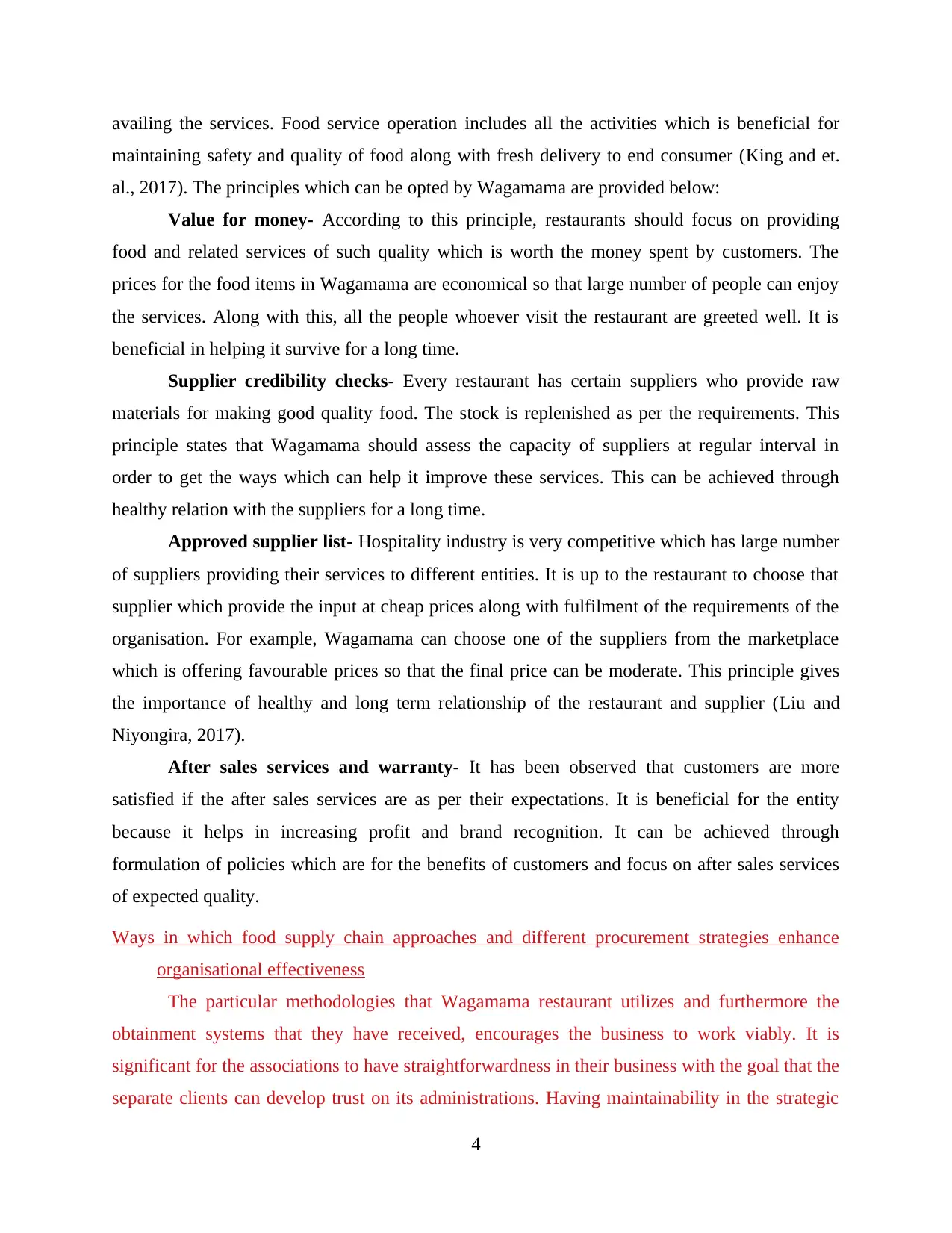
availing the services. Food service operation includes all the activities which is beneficial for
maintaining safety and quality of food along with fresh delivery to end consumer (King and et.
al., 2017). The principles which can be opted by Wagamama are provided below:
Value for money- According to this principle, restaurants should focus on providing
food and related services of such quality which is worth the money spent by customers. The
prices for the food items in Wagamama are economical so that large number of people can enjoy
the services. Along with this, all the people whoever visit the restaurant are greeted well. It is
beneficial in helping it survive for a long time.
Supplier credibility checks- Every restaurant has certain suppliers who provide raw
materials for making good quality food. The stock is replenished as per the requirements. This
principle states that Wagamama should assess the capacity of suppliers at regular interval in
order to get the ways which can help it improve these services. This can be achieved through
healthy relation with the suppliers for a long time.
Approved supplier list- Hospitality industry is very competitive which has large number
of suppliers providing their services to different entities. It is up to the restaurant to choose that
supplier which provide the input at cheap prices along with fulfilment of the requirements of the
organisation. For example, Wagamama can choose one of the suppliers from the marketplace
which is offering favourable prices so that the final price can be moderate. This principle gives
the importance of healthy and long term relationship of the restaurant and supplier (Liu and
Niyongira, 2017).
After sales services and warranty- It has been observed that customers are more
satisfied if the after sales services are as per their expectations. It is beneficial for the entity
because it helps in increasing profit and brand recognition. It can be achieved through
formulation of policies which are for the benefits of customers and focus on after sales services
of expected quality.
Ways in which food supply chain approaches and different procurement strategies enhance
organisational effectiveness
The particular methodologies that Wagamama restaurant utilizes and furthermore the
obtainment systems that they have received, encourages the business to work viably. It is
significant for the associations to have straightforwardness in their business with the goal that the
separate clients can develop trust on its administrations. Having maintainability in the strategic
4
maintaining safety and quality of food along with fresh delivery to end consumer (King and et.
al., 2017). The principles which can be opted by Wagamama are provided below:
Value for money- According to this principle, restaurants should focus on providing
food and related services of such quality which is worth the money spent by customers. The
prices for the food items in Wagamama are economical so that large number of people can enjoy
the services. Along with this, all the people whoever visit the restaurant are greeted well. It is
beneficial in helping it survive for a long time.
Supplier credibility checks- Every restaurant has certain suppliers who provide raw
materials for making good quality food. The stock is replenished as per the requirements. This
principle states that Wagamama should assess the capacity of suppliers at regular interval in
order to get the ways which can help it improve these services. This can be achieved through
healthy relation with the suppliers for a long time.
Approved supplier list- Hospitality industry is very competitive which has large number
of suppliers providing their services to different entities. It is up to the restaurant to choose that
supplier which provide the input at cheap prices along with fulfilment of the requirements of the
organisation. For example, Wagamama can choose one of the suppliers from the marketplace
which is offering favourable prices so that the final price can be moderate. This principle gives
the importance of healthy and long term relationship of the restaurant and supplier (Liu and
Niyongira, 2017).
After sales services and warranty- It has been observed that customers are more
satisfied if the after sales services are as per their expectations. It is beneficial for the entity
because it helps in increasing profit and brand recognition. It can be achieved through
formulation of policies which are for the benefits of customers and focus on after sales services
of expected quality.
Ways in which food supply chain approaches and different procurement strategies enhance
organisational effectiveness
The particular methodologies that Wagamama restaurant utilizes and furthermore the
obtainment systems that they have received, encourages the business to work viably. It is
significant for the associations to have straightforwardness in their business with the goal that the
separate clients can develop trust on its administrations. Having maintainability in the strategic
4
Paraphrase This Document
Need a fresh take? Get an instant paraphrase of this document with our AI Paraphraser
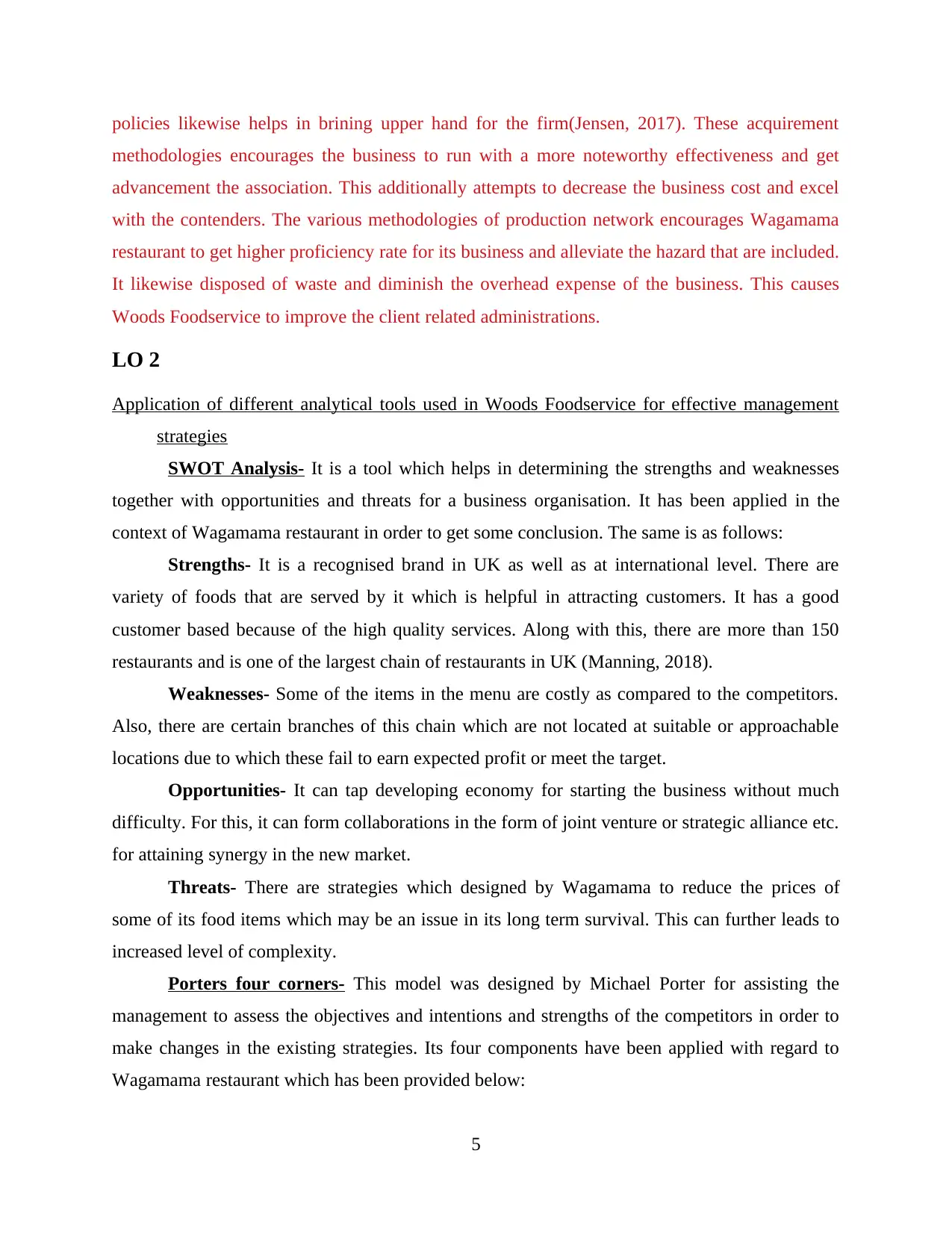
policies likewise helps in brining upper hand for the firm(Jensen, 2017). These acquirement
methodologies encourages the business to run with a more noteworthy effectiveness and get
advancement the association. This additionally attempts to decrease the business cost and excel
with the contenders. The various methodologies of production network encourages Wagamama
restaurant to get higher proficiency rate for its business and alleviate the hazard that are included.
It likewise disposed of waste and diminish the overhead expense of the business. This causes
Woods Foodservice to improve the client related administrations.
LO 2
Application of different analytical tools used in Woods Foodservice for effective management
strategies
SWOT Analysis- It is a tool which helps in determining the strengths and weaknesses
together with opportunities and threats for a business organisation. It has been applied in the
context of Wagamama restaurant in order to get some conclusion. The same is as follows:
Strengths- It is a recognised brand in UK as well as at international level. There are
variety of foods that are served by it which is helpful in attracting customers. It has a good
customer based because of the high quality services. Along with this, there are more than 150
restaurants and is one of the largest chain of restaurants in UK (Manning, 2018).
Weaknesses- Some of the items in the menu are costly as compared to the competitors.
Also, there are certain branches of this chain which are not located at suitable or approachable
locations due to which these fail to earn expected profit or meet the target.
Opportunities- It can tap developing economy for starting the business without much
difficulty. For this, it can form collaborations in the form of joint venture or strategic alliance etc.
for attaining synergy in the new market.
Threats- There are strategies which designed by Wagamama to reduce the prices of
some of its food items which may be an issue in its long term survival. This can further leads to
increased level of complexity.
Porters four corners- This model was designed by Michael Porter for assisting the
management to assess the objectives and intentions and strengths of the competitors in order to
make changes in the existing strategies. Its four components have been applied with regard to
Wagamama restaurant which has been provided below:
5
methodologies encourages the business to run with a more noteworthy effectiveness and get
advancement the association. This additionally attempts to decrease the business cost and excel
with the contenders. The various methodologies of production network encourages Wagamama
restaurant to get higher proficiency rate for its business and alleviate the hazard that are included.
It likewise disposed of waste and diminish the overhead expense of the business. This causes
Woods Foodservice to improve the client related administrations.
LO 2
Application of different analytical tools used in Woods Foodservice for effective management
strategies
SWOT Analysis- It is a tool which helps in determining the strengths and weaknesses
together with opportunities and threats for a business organisation. It has been applied in the
context of Wagamama restaurant in order to get some conclusion. The same is as follows:
Strengths- It is a recognised brand in UK as well as at international level. There are
variety of foods that are served by it which is helpful in attracting customers. It has a good
customer based because of the high quality services. Along with this, there are more than 150
restaurants and is one of the largest chain of restaurants in UK (Manning, 2018).
Weaknesses- Some of the items in the menu are costly as compared to the competitors.
Also, there are certain branches of this chain which are not located at suitable or approachable
locations due to which these fail to earn expected profit or meet the target.
Opportunities- It can tap developing economy for starting the business without much
difficulty. For this, it can form collaborations in the form of joint venture or strategic alliance etc.
for attaining synergy in the new market.
Threats- There are strategies which designed by Wagamama to reduce the prices of
some of its food items which may be an issue in its long term survival. This can further leads to
increased level of complexity.
Porters four corners- This model was designed by Michael Porter for assisting the
management to assess the objectives and intentions and strengths of the competitors in order to
make changes in the existing strategies. Its four components have been applied with regard to
Wagamama restaurant which has been provided below:
5
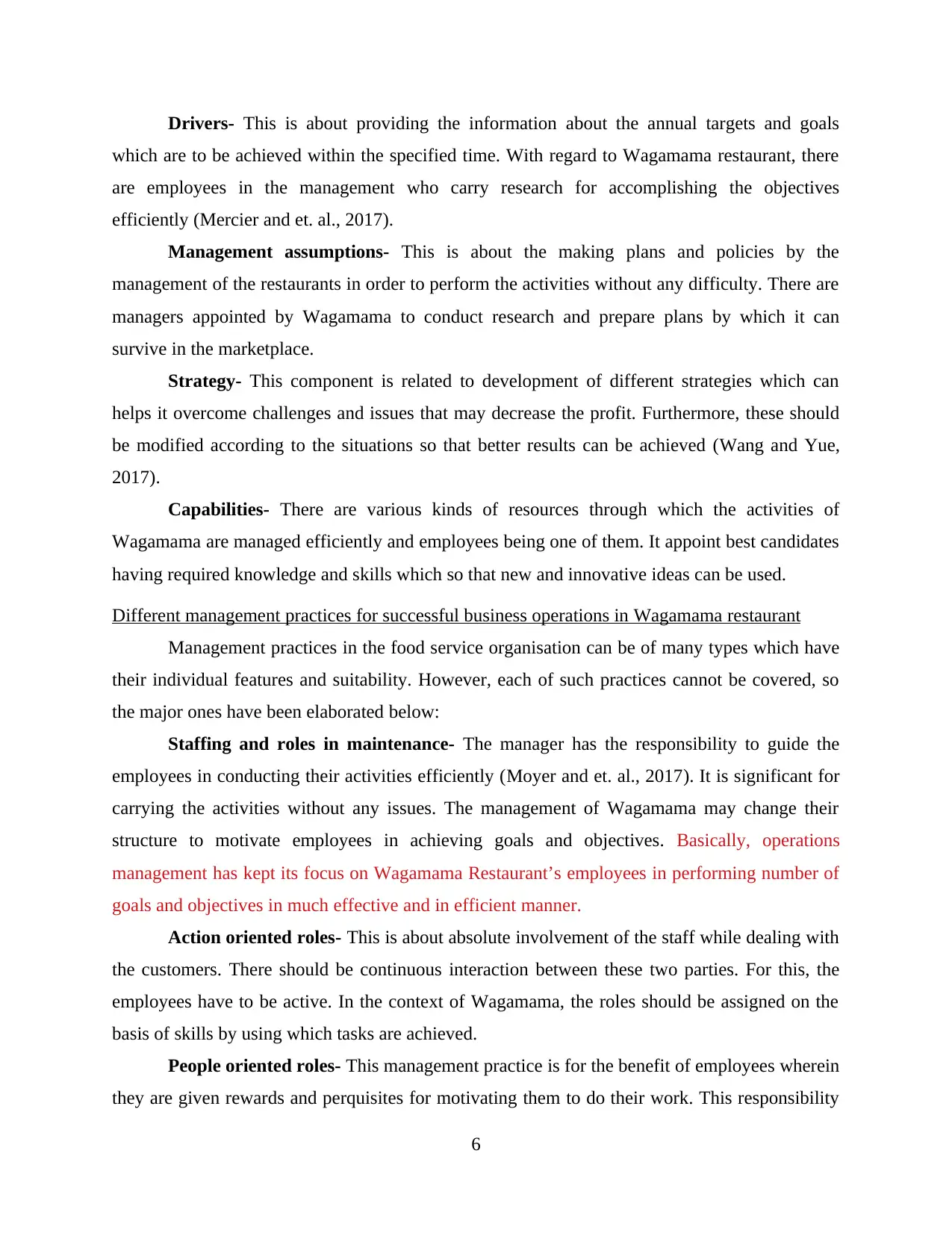
Drivers- This is about providing the information about the annual targets and goals
which are to be achieved within the specified time. With regard to Wagamama restaurant, there
are employees in the management who carry research for accomplishing the objectives
efficiently (Mercier and et. al., 2017).
Management assumptions- This is about the making plans and policies by the
management of the restaurants in order to perform the activities without any difficulty. There are
managers appointed by Wagamama to conduct research and prepare plans by which it can
survive in the marketplace.
Strategy- This component is related to development of different strategies which can
helps it overcome challenges and issues that may decrease the profit. Furthermore, these should
be modified according to the situations so that better results can be achieved (Wang and Yue,
2017).
Capabilities- There are various kinds of resources through which the activities of
Wagamama are managed efficiently and employees being one of them. It appoint best candidates
having required knowledge and skills which so that new and innovative ideas can be used.
Different management practices for successful business operations in Wagamama restaurant
Management practices in the food service organisation can be of many types which have
their individual features and suitability. However, each of such practices cannot be covered, so
the major ones have been elaborated below:
Staffing and roles in maintenance- The manager has the responsibility to guide the
employees in conducting their activities efficiently (Moyer and et. al., 2017). It is significant for
carrying the activities without any issues. The management of Wagamama may change their
structure to motivate employees in achieving goals and objectives. Basically, operations
management has kept its focus on Wagamama Restaurant’s employees in performing number of
goals and objectives in much effective and in efficient manner.
Action oriented roles- This is about absolute involvement of the staff while dealing with
the customers. There should be continuous interaction between these two parties. For this, the
employees have to be active. In the context of Wagamama, the roles should be assigned on the
basis of skills by using which tasks are achieved.
People oriented roles- This management practice is for the benefit of employees wherein
they are given rewards and perquisites for motivating them to do their work. This responsibility
6
which are to be achieved within the specified time. With regard to Wagamama restaurant, there
are employees in the management who carry research for accomplishing the objectives
efficiently (Mercier and et. al., 2017).
Management assumptions- This is about the making plans and policies by the
management of the restaurants in order to perform the activities without any difficulty. There are
managers appointed by Wagamama to conduct research and prepare plans by which it can
survive in the marketplace.
Strategy- This component is related to development of different strategies which can
helps it overcome challenges and issues that may decrease the profit. Furthermore, these should
be modified according to the situations so that better results can be achieved (Wang and Yue,
2017).
Capabilities- There are various kinds of resources through which the activities of
Wagamama are managed efficiently and employees being one of them. It appoint best candidates
having required knowledge and skills which so that new and innovative ideas can be used.
Different management practices for successful business operations in Wagamama restaurant
Management practices in the food service organisation can be of many types which have
their individual features and suitability. However, each of such practices cannot be covered, so
the major ones have been elaborated below:
Staffing and roles in maintenance- The manager has the responsibility to guide the
employees in conducting their activities efficiently (Moyer and et. al., 2017). It is significant for
carrying the activities without any issues. The management of Wagamama may change their
structure to motivate employees in achieving goals and objectives. Basically, operations
management has kept its focus on Wagamama Restaurant’s employees in performing number of
goals and objectives in much effective and in efficient manner.
Action oriented roles- This is about absolute involvement of the staff while dealing with
the customers. There should be continuous interaction between these two parties. For this, the
employees have to be active. In the context of Wagamama, the roles should be assigned on the
basis of skills by using which tasks are achieved.
People oriented roles- This management practice is for the benefit of employees wherein
they are given rewards and perquisites for motivating them to do their work. This responsibility
6
⊘ This is a preview!⊘
Do you want full access?
Subscribe today to unlock all pages.

Trusted by 1+ million students worldwide
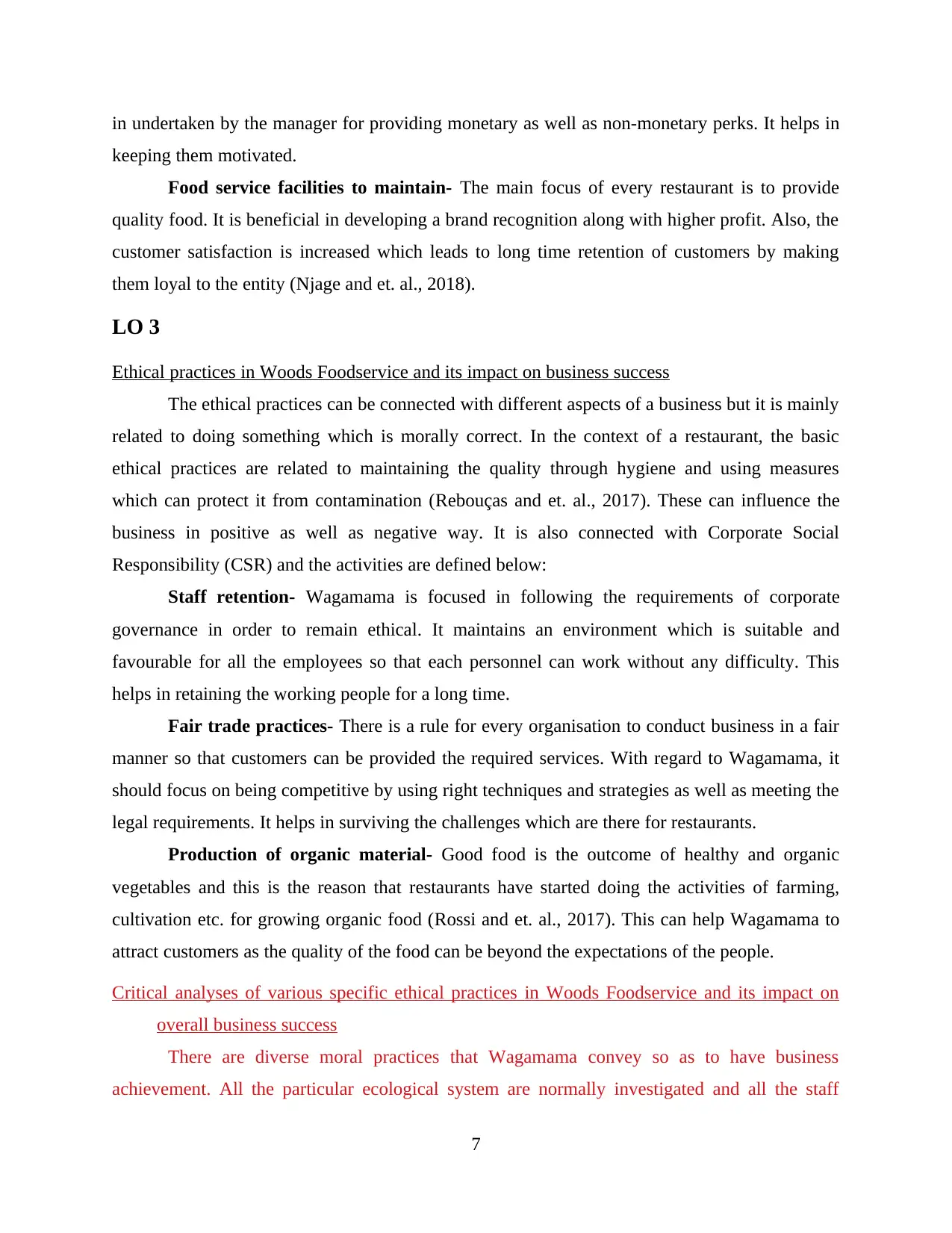
in undertaken by the manager for providing monetary as well as non-monetary perks. It helps in
keeping them motivated.
Food service facilities to maintain- The main focus of every restaurant is to provide
quality food. It is beneficial in developing a brand recognition along with higher profit. Also, the
customer satisfaction is increased which leads to long time retention of customers by making
them loyal to the entity (Njage and et. al., 2018).
LO 3
Ethical practices in Woods Foodservice and its impact on business success
The ethical practices can be connected with different aspects of a business but it is mainly
related to doing something which is morally correct. In the context of a restaurant, the basic
ethical practices are related to maintaining the quality through hygiene and using measures
which can protect it from contamination (Rebouças and et. al., 2017). These can influence the
business in positive as well as negative way. It is also connected with Corporate Social
Responsibility (CSR) and the activities are defined below:
Staff retention- Wagamama is focused in following the requirements of corporate
governance in order to remain ethical. It maintains an environment which is suitable and
favourable for all the employees so that each personnel can work without any difficulty. This
helps in retaining the working people for a long time.
Fair trade practices- There is a rule for every organisation to conduct business in a fair
manner so that customers can be provided the required services. With regard to Wagamama, it
should focus on being competitive by using right techniques and strategies as well as meeting the
legal requirements. It helps in surviving the challenges which are there for restaurants.
Production of organic material- Good food is the outcome of healthy and organic
vegetables and this is the reason that restaurants have started doing the activities of farming,
cultivation etc. for growing organic food (Rossi and et. al., 2017). This can help Wagamama to
attract customers as the quality of the food can be beyond the expectations of the people.
Critical analyses of various specific ethical practices in Woods Foodservice and its impact on
overall business success
There are diverse moral practices that Wagamama convey so as to have business
achievement. All the particular ecological system are normally investigated and all the staff
7
keeping them motivated.
Food service facilities to maintain- The main focus of every restaurant is to provide
quality food. It is beneficial in developing a brand recognition along with higher profit. Also, the
customer satisfaction is increased which leads to long time retention of customers by making
them loyal to the entity (Njage and et. al., 2018).
LO 3
Ethical practices in Woods Foodservice and its impact on business success
The ethical practices can be connected with different aspects of a business but it is mainly
related to doing something which is morally correct. In the context of a restaurant, the basic
ethical practices are related to maintaining the quality through hygiene and using measures
which can protect it from contamination (Rebouças and et. al., 2017). These can influence the
business in positive as well as negative way. It is also connected with Corporate Social
Responsibility (CSR) and the activities are defined below:
Staff retention- Wagamama is focused in following the requirements of corporate
governance in order to remain ethical. It maintains an environment which is suitable and
favourable for all the employees so that each personnel can work without any difficulty. This
helps in retaining the working people for a long time.
Fair trade practices- There is a rule for every organisation to conduct business in a fair
manner so that customers can be provided the required services. With regard to Wagamama, it
should focus on being competitive by using right techniques and strategies as well as meeting the
legal requirements. It helps in surviving the challenges which are there for restaurants.
Production of organic material- Good food is the outcome of healthy and organic
vegetables and this is the reason that restaurants have started doing the activities of farming,
cultivation etc. for growing organic food (Rossi and et. al., 2017). This can help Wagamama to
attract customers as the quality of the food can be beyond the expectations of the people.
Critical analyses of various specific ethical practices in Woods Foodservice and its impact on
overall business success
There are diverse moral practices that Wagamama convey so as to have business
achievement. All the particular ecological system are normally investigated and all the staff
7
Paraphrase This Document
Need a fresh take? Get an instant paraphrase of this document with our AI Paraphraser
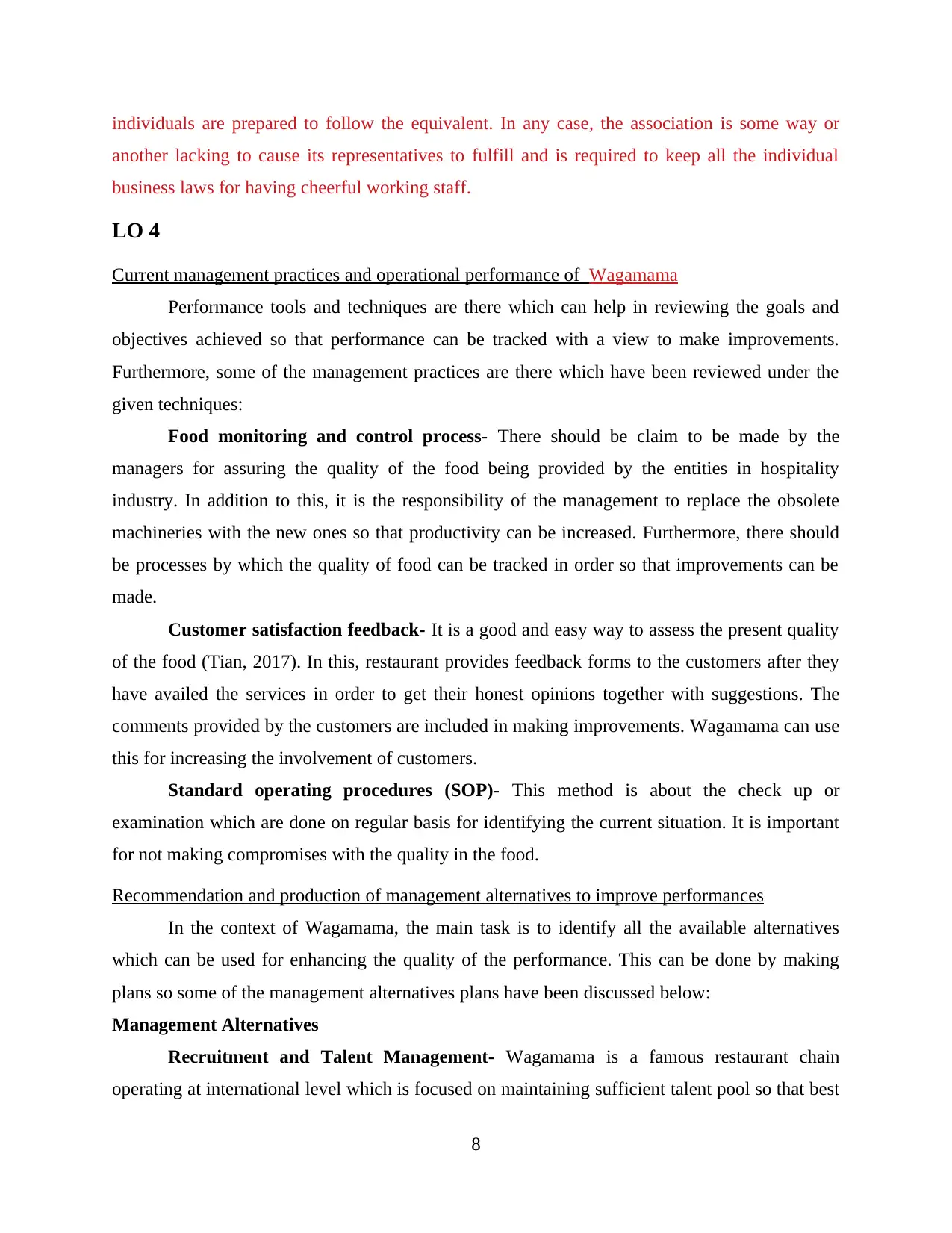
individuals are prepared to follow the equivalent. In any case, the association is some way or
another lacking to cause its representatives to fulfill and is required to keep all the individual
business laws for having cheerful working staff.
LO 4
Current management practices and operational performance of Wagamama
Performance tools and techniques are there which can help in reviewing the goals and
objectives achieved so that performance can be tracked with a view to make improvements.
Furthermore, some of the management practices are there which have been reviewed under the
given techniques:
Food monitoring and control process- There should be claim to be made by the
managers for assuring the quality of the food being provided by the entities in hospitality
industry. In addition to this, it is the responsibility of the management to replace the obsolete
machineries with the new ones so that productivity can be increased. Furthermore, there should
be processes by which the quality of food can be tracked in order so that improvements can be
made.
Customer satisfaction feedback- It is a good and easy way to assess the present quality
of the food (Tian, 2017). In this, restaurant provides feedback forms to the customers after they
have availed the services in order to get their honest opinions together with suggestions. The
comments provided by the customers are included in making improvements. Wagamama can use
this for increasing the involvement of customers.
Standard operating procedures (SOP)- This method is about the check up or
examination which are done on regular basis for identifying the current situation. It is important
for not making compromises with the quality in the food.
Recommendation and production of management alternatives to improve performances
In the context of Wagamama, the main task is to identify all the available alternatives
which can be used for enhancing the quality of the performance. This can be done by making
plans so some of the management alternatives plans have been discussed below:
Management Alternatives
Recruitment and Talent Management- Wagamama is a famous restaurant chain
operating at international level which is focused on maintaining sufficient talent pool so that best
8
another lacking to cause its representatives to fulfill and is required to keep all the individual
business laws for having cheerful working staff.
LO 4
Current management practices and operational performance of Wagamama
Performance tools and techniques are there which can help in reviewing the goals and
objectives achieved so that performance can be tracked with a view to make improvements.
Furthermore, some of the management practices are there which have been reviewed under the
given techniques:
Food monitoring and control process- There should be claim to be made by the
managers for assuring the quality of the food being provided by the entities in hospitality
industry. In addition to this, it is the responsibility of the management to replace the obsolete
machineries with the new ones so that productivity can be increased. Furthermore, there should
be processes by which the quality of food can be tracked in order so that improvements can be
made.
Customer satisfaction feedback- It is a good and easy way to assess the present quality
of the food (Tian, 2017). In this, restaurant provides feedback forms to the customers after they
have availed the services in order to get their honest opinions together with suggestions. The
comments provided by the customers are included in making improvements. Wagamama can use
this for increasing the involvement of customers.
Standard operating procedures (SOP)- This method is about the check up or
examination which are done on regular basis for identifying the current situation. It is important
for not making compromises with the quality in the food.
Recommendation and production of management alternatives to improve performances
In the context of Wagamama, the main task is to identify all the available alternatives
which can be used for enhancing the quality of the performance. This can be done by making
plans so some of the management alternatives plans have been discussed below:
Management Alternatives
Recruitment and Talent Management- Wagamama is a famous restaurant chain
operating at international level which is focused on maintaining sufficient talent pool so that best
8
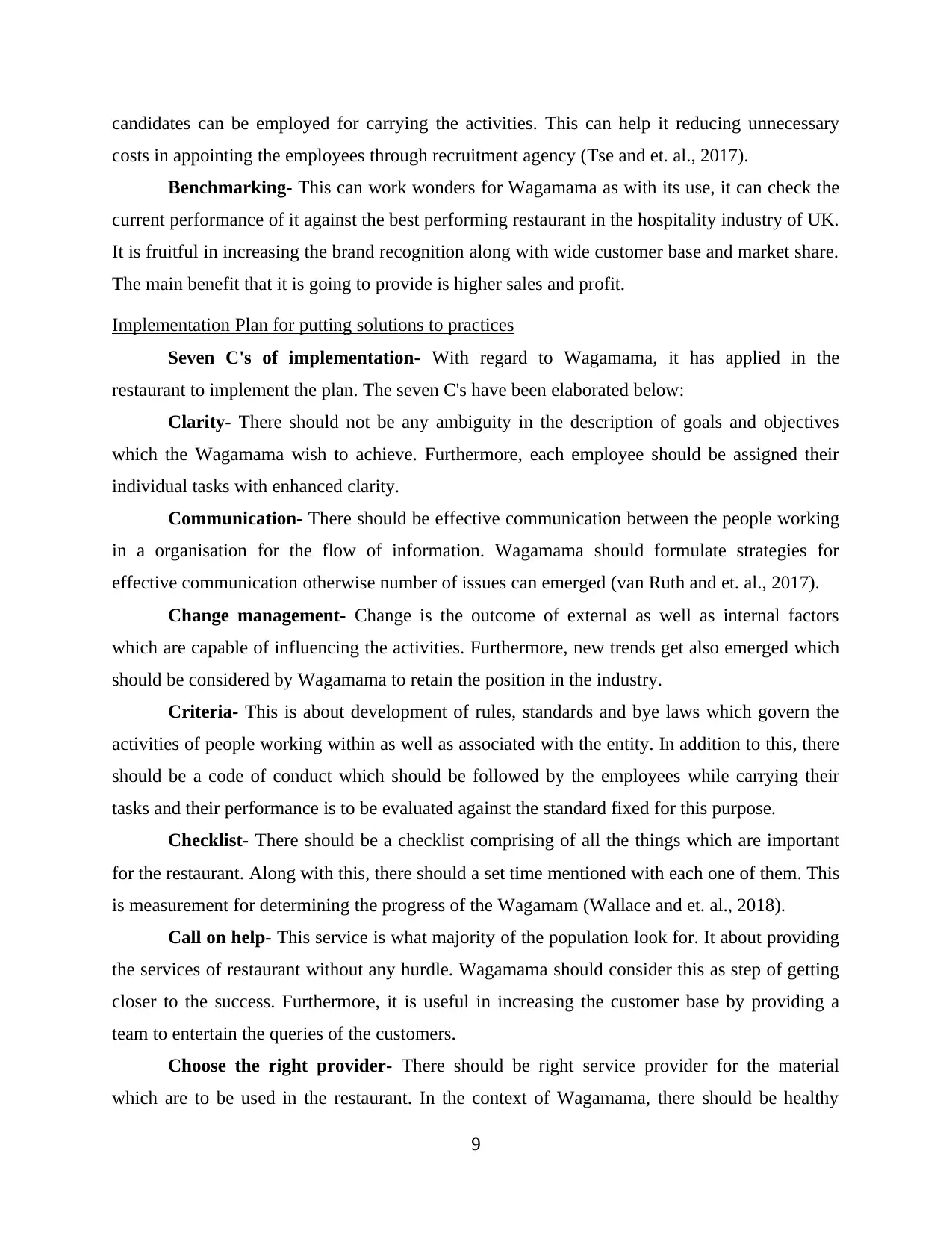
candidates can be employed for carrying the activities. This can help it reducing unnecessary
costs in appointing the employees through recruitment agency (Tse and et. al., 2017).
Benchmarking- This can work wonders for Wagamama as with its use, it can check the
current performance of it against the best performing restaurant in the hospitality industry of UK.
It is fruitful in increasing the brand recognition along with wide customer base and market share.
The main benefit that it is going to provide is higher sales and profit.
Implementation Plan for putting solutions to practices
Seven C's of implementation- With regard to Wagamama, it has applied in the
restaurant to implement the plan. The seven C's have been elaborated below:
Clarity- There should not be any ambiguity in the description of goals and objectives
which the Wagamama wish to achieve. Furthermore, each employee should be assigned their
individual tasks with enhanced clarity.
Communication- There should be effective communication between the people working
in a organisation for the flow of information. Wagamama should formulate strategies for
effective communication otherwise number of issues can emerged (van Ruth and et. al., 2017).
Change management- Change is the outcome of external as well as internal factors
which are capable of influencing the activities. Furthermore, new trends get also emerged which
should be considered by Wagamama to retain the position in the industry.
Criteria- This is about development of rules, standards and bye laws which govern the
activities of people working within as well as associated with the entity. In addition to this, there
should be a code of conduct which should be followed by the employees while carrying their
tasks and their performance is to be evaluated against the standard fixed for this purpose.
Checklist- There should be a checklist comprising of all the things which are important
for the restaurant. Along with this, there should a set time mentioned with each one of them. This
is measurement for determining the progress of the Wagamam (Wallace and et. al., 2018).
Call on help- This service is what majority of the population look for. It about providing
the services of restaurant without any hurdle. Wagamama should consider this as step of getting
closer to the success. Furthermore, it is useful in increasing the customer base by providing a
team to entertain the queries of the customers.
Choose the right provider- There should be right service provider for the material
which are to be used in the restaurant. In the context of Wagamama, there should be healthy
9
costs in appointing the employees through recruitment agency (Tse and et. al., 2017).
Benchmarking- This can work wonders for Wagamama as with its use, it can check the
current performance of it against the best performing restaurant in the hospitality industry of UK.
It is fruitful in increasing the brand recognition along with wide customer base and market share.
The main benefit that it is going to provide is higher sales and profit.
Implementation Plan for putting solutions to practices
Seven C's of implementation- With regard to Wagamama, it has applied in the
restaurant to implement the plan. The seven C's have been elaborated below:
Clarity- There should not be any ambiguity in the description of goals and objectives
which the Wagamama wish to achieve. Furthermore, each employee should be assigned their
individual tasks with enhanced clarity.
Communication- There should be effective communication between the people working
in a organisation for the flow of information. Wagamama should formulate strategies for
effective communication otherwise number of issues can emerged (van Ruth and et. al., 2017).
Change management- Change is the outcome of external as well as internal factors
which are capable of influencing the activities. Furthermore, new trends get also emerged which
should be considered by Wagamama to retain the position in the industry.
Criteria- This is about development of rules, standards and bye laws which govern the
activities of people working within as well as associated with the entity. In addition to this, there
should be a code of conduct which should be followed by the employees while carrying their
tasks and their performance is to be evaluated against the standard fixed for this purpose.
Checklist- There should be a checklist comprising of all the things which are important
for the restaurant. Along with this, there should a set time mentioned with each one of them. This
is measurement for determining the progress of the Wagamam (Wallace and et. al., 2018).
Call on help- This service is what majority of the population look for. It about providing
the services of restaurant without any hurdle. Wagamama should consider this as step of getting
closer to the success. Furthermore, it is useful in increasing the customer base by providing a
team to entertain the queries of the customers.
Choose the right provider- There should be right service provider for the material
which are to be used in the restaurant. In the context of Wagamama, there should be healthy
9
⊘ This is a preview!⊘
Do you want full access?
Subscribe today to unlock all pages.

Trusted by 1+ million students worldwide
1 out of 14
Related Documents
Your All-in-One AI-Powered Toolkit for Academic Success.
+13062052269
info@desklib.com
Available 24*7 on WhatsApp / Email
![[object Object]](/_next/static/media/star-bottom.7253800d.svg)
Unlock your academic potential
Copyright © 2020–2025 A2Z Services. All Rights Reserved. Developed and managed by ZUCOL.




